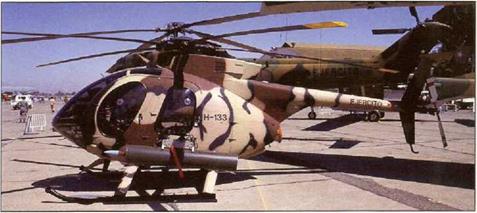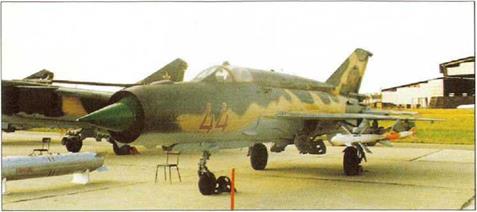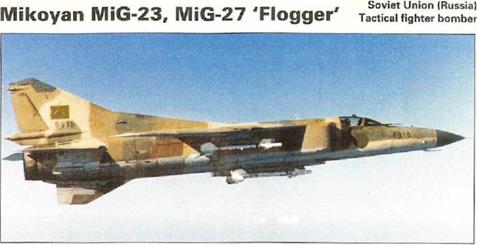MD Helicopters MD 500, MD900
|
|
H |
ughes’ YH0-6 design was developed to moot s I960 US Army requirement for a light observation helicopter. The production OH-6A Cayuse entered service in 1965 and was widely used in Vietnam. The civilian Hughes 500 introduced an uprated engine, increased fuel and a revised interior, The first military variant was the Model 500M Defender The 50DM/ASW has a MAD ‘bird’ ana can carry torpedoes. The civilian 500D variant introduced a slow-turning five-bladed rotor and a T tail. It was built undei licence in Japan as the OH-6D The military Model 500MD Defender had armour protection and IR exhaust suppressors. Variants have been developed tor ASW, anti-tank and scout duties. The Model 500E introduced a revised, pointed nose, more spacious interior and an Allison 250 C20B engine. Dedicated military models are designated 500MG Defender. The up – engined 530MG Defender had options for a mast – mounted TOW sight, FUR, RHAW gear, IFF and a laser rangefinder, and can be armed with TOW 2 missiles, 2.75 in rockets and Stinger AAMs The US Army has developed a family of special- missions variants called the ‘Little Birds’, which are operated by the 160th Special Operations Aviation Regiment. Current service variants include the FLIR-equipped MH-6H special forces insertion aircraft, and the armed AH-6G Equivalent aircraft fitted with the NOTAR (NO ТАІІ Rotor) system are designated MH-6J and AH-6J
In the rr d-1990s South Korea developed the licence-built armeo MD520MK Black Tiger The
assembly work was undertaken by the engineering departmental Korean Air Lines.
Hughes helicopters was acquired by McDonnell Douglas in 1984. When Boeing merged with McDonnell Douglas in 1997, McDonnell Douglas Helicopters was sold off, and acquired by a Dutch company to become MD Helicopters. MD Helicopters continues to offer military variants of the MD 530MG model, but is also working on armed versions of the MD 900 Explorer
The Explorer, which first flew in December 1992, is much larger and more advanced than the Model 500/520 and uses the NOTAR anti-torque system instead of a conventional tail rotor A proposed combat-capable version was announced in 1995, designated the Combat Explorer, but in 2000 MD Helicopters developed a simplified gun/rocket package to equip the Explorers already in service with the Mexican navy. The Explorer was also evaluated by the US Coast Guard.
 Specification: MD Helicopters Model 500 Powerplanfcone 236-<W (317-hp) Allison 250-C18A turbnshafl
Specification: MD Helicopters Model 500 Powerplanfcone 236-<W (317-hp) Allison 250-C18A turbnshafl
Dimensions: mail rotor diameter 8.03 m (26 fl 4 in); length overall, rotors turring 3.24 m (30 ft Ш in); height 7.48 tn (8 ft Un Weights: empty 493 kg (1,038 lb}: max тілі take-off 1361 kg (3.003 lb)
Performance: maximum level sueed 244 kmh (152 moh|; maximum rate of climb at sea level 518 m (700 ft) per minute; service ceiling 4390 m (14,400 ft), hovering ceiling 2500 m 18,200 ft) IGE. 1615 m 15,300 ft) 0GE: rarge 505 km 1307 miles)
Armament two external hardpoints for gun pods, rockets or TOW missiles
Soviet Union (Russia) Lightweight fighter
|
|
T |
he original MiG-21 was developed as a light.
high performance, short-range interceptor. Early MiG-21F-13 ‘Fishbed-Cs’ were armed with one NR-30 cannon, and two AA-2 ‘Atoll’ AAMs, while the MiG-2lP ‘Fishbed-D’ dispensed with the cannon armament altogether, but introduced R1L radar, The R-11 F2-300-engined MiG-21PF was similar, although late MiG-21PF ‘Fishbed-Es’ introduced a broader-chord fin_and provision for an external GP9 cannon pod. The R-1 lF-300-engmed MiG-21FL was for export, The MiG-21PFS and MiG-21PFM had two-piece canopies, blown SPS flaps and the R-11F2S-300 engine.
All later variants had blown flaps, two-piece canopies, broad-chord tailfins and four pylons. The MiG-21 PFM-based reconnaissance MiG-21R had an enlarged dorsal fairing and provision for centreline reconnaissance pods. The MiG-21S was similar, with a centreline GP9. The R-13-300-engined MiG-21SM put the GSh-23L cannon in a fixed installation, instead of in the removeable GP9 gondola. The R-11F2S-300 engined export MiG-21 M was built under licence in India, while the MiG-2lMF introduced AAM capability on all four pylons. The MiG-21MT used the more powerful R-13F-300 engine, while the MiG-21SMT ‘Fishbed-K’ was fitted
with a further enlarged spine. Significant numbers of MiG-21 Rs, MiG-21 Ms and MiG-21 MFs remain in service. The multi-role R-25-300-powered MiG-21bis introduced improved avionics, AA-8 ‘Aphid’ AAMs, and improved Sapphire-21 radar.
The MiG-21U ‘Mongol-A’ tandem two-seat trainer could carry a centreline gun pod and had two underwing pylons, The MiG-21 US ‘Mongol-B’ had increased fin chord, improved ejection seats, a bigger spine, a retractable periscope and blown SPS flaps, while the MiG-21 UM was similar, with updated instruments and avionics.
The number of MiG-21 s in service has declined dramatically since the end of the Cold War, with force reductions and a growing trend for ex- Warsaw Pact nations to turn to the West for combat aircraft. Aerostar and Elbit are jointly upgrading 110 Romanian air force MiG-21 s to Lancer standards, with new radar, digital databus, cockpit, avionics and weapons. Romania’s Lancer Is are upgraded MiG-21 M/MFs, while the Lancer II is an upgraded MiG-21 UM/US. The Lancer III is aimed at the export market, and based on the MiG-21 bis
Mikoyan and the Sokol plant are upgrading 125 MiG-21 s to MiG-21-93 standard for the Indian Air Force, adding new radar, weapons and systems.
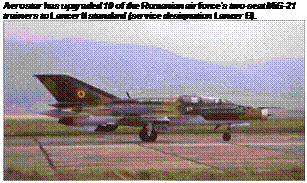 Specification: MiG-21 bis Fishbed-M’ Powerplant: ore Tumanskii R-25-330 Uirbcjct rated at 69.58 kN (15,650 Ibl Dimensions: wing spar 7,15m (23 ft 5Yi in): length 15.76 m (51 ft 8/ in) including probe, height A. 12 m (13 ft 6 2 in)
Specification: MiG-21 bis Fishbed-M’ Powerplant: ore Tumanskii R-25-330 Uirbcjct rated at 69.58 kN (15,650 Ibl Dimensions: wing spar 7,15m (23 ft 5Yi in): length 15.76 m (51 ft 8/ in) including probe, height A. 12 m (13 ft 6 2 in)
Weights: empty 5350 eg (11,705 lb): maximum takeoff 9661 <g (21,299 lb)
Performance: maximum level speed 2230 kmh |l,385 mpb); maximum rate of climb at sea level 7200 m (23,622 ft) per minute; service ceiling 19000 m (62,336 ft), typical combat radius 150-500 km (280-311 miles) Armament: one centreline twin-barrelled GSh-23 23-mm cannon, with 2000-kg (4,409 lb) of ordnance on four underwing hardpoints
|
|
T |
he MiG-23 was developed as a MiG-21 replacement, with greater range and firepower. It was ordered into production as the MiG-23S. The MiG-23M and export MiG-23MF ‘Flogger-B’ had ‘High Lark’ pulse-Doppler radar, an IRST, AA-7 ‘Apex’ missiles, and a shortened rear fuselage. Some remain in use with Bulgaria, Cuba, India, Romania and Syria. The down-graded MIG-23MS JFlogger-E’ was an export version with ‘Jay Bird’ radar, and no BVR missile, and remains in service with Algeria, Libya and perhaps Syria.
The lightweight MiG-23ML ‘Flogger-G’ introduced airframe, engine, radar and avionics improvements. Aircraft remain in service in Angola, Bulgaria, Cuba, Iraq, North Korea. Syria and Yemen. The MiG-23P was a dedicated PVO interceptor. The fina MiG-23MLD ‘Flogger-K’ fighter variant is still used by Belarus. Kazakhstan and Bulgaria.
The attack-dedicated MiG-23B/BN ‘Flogger-F’ had an upgraded nav/attack system and a derated R-29B-300 engine. The JFlogger-H’ introduced a new RWFL MiG-23BNs were exported to Algeria, Angola, Bulgaria, Cuba. Czechoslovakia, East Germany, Ethiopia, India. Iraq and Syria. The MiG-23UB ‘Flogger-C’ is a tandem two-seat trainer version delivered to all MiG-23/-27 operators.
The MiG-27 remedied the deficiencies and reduced the cost of the ground-attack. ‘Flogger’. It introduced simplified, fixed intakes, and an engine with a two-position afterburner nozzle. Fuel economy
is improved and weight mduced, at the expense of performance. A new GSh-6-30 30-mm cannon replaced the original 23-mm cannon, The MiG-27 ‘Flogger-D’ had the same avionics as the MiG – 23BN, with a Fone laser rangefinder and it first flew in prototype form in 1972.
The ‘straight’ MiG-27 was soon replaced by the MiG-27M ‘Flogger-J’, which was equipped with the PrNK-23M nav/attack system and a Klyon laser rangefinder, and which introduced fixed wing leading edge root extensions housing Beryoza RWR antennas. India was the only export customer for the MiG-27, and builds the type under licence.
The most advanced member of the family was the IVUG-27K ‘Flogger-J2’, deployed from 1977. This had a Kaira-24 laser designator in an undernose fairing with a TV system in the enlarged, oval nose window, with a De! ta-2NG missile guidance transmitter antenna in a ‘pimple’ on the tip of the nose, re-located from its usual location on the glove pylons. The twin pitot probes were mounted low on the nose.
 Specification: MiG 23ML ‘Flogger-G’ Powerplant: one 12/719 kN (28,66Q-lb| MNPK ‘Soyuz (Khachatourov) R-35-300 afterburning turbojet
Specification: MiG 23ML ‘Flogger-G’ Powerplant: one 12/719 kN (28,66Q-lb| MNPK ‘Soyuz (Khachatourov) R-35-300 afterburning turbojet
Dimensions: wing spar – ■ 3.97 m|45 ft 10 in) spread ЕП" 7.78 m (25 ft 6/ in) swept, length 1670 nt (54 ft Ш in); heglrt 4,82 m Weights: empty 10200 kg (22.487 lb); maximum take-aff 17800 kg 139,242 lb) Performance: maximum leve: speed 2590 kmh (1.553 mph); maximum rate of climb at sea aval 14400 m (47.244 ft) per minute; service ceding 18500 m (50,695 ft); combat radius 1150 km (715 miles) with six AAMs Armament: one GSh-23 23-mm cannon; maximum ordnance 3000 kg (6.613 lb)
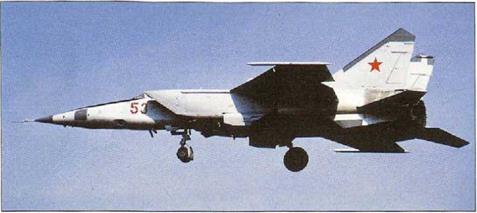
|
T |
he MiG-25 (NATO code-name ‘Foxbat’) was developed to counter the high-flying Mach 3 XB-70 strategic bomber. It featured advanced construct on techniques, us ng tempered steel for most of the airframe with titanium for the eading edges. The prototype Ye-155P-1 flew on 9 September 1964, powered by a pair of 100 kN {22.500-lb) Mikulin R-15B-300 turbojets.
Production of the refined MiG-25P ‘Foxbat-A’ fighter began in 1969, and it entered service in 1973. The definitive MiG-25PD ‘Foxbat-E’ featured a new RP-25 look-down/shoot-down radar, an IRST, more powerful R-15BD-300 turbojets and provision for з iarge 5300-litre (1,166-Imp gal) belly tank. About 370 surviving ‘Foxbat-As’ were brought up to PD standard, as the MiG-25PDS. Some MiG-25PDs were fitted with a 250-mm {10-ir) nose plug to allow installation of a retractable IFR probe, taking overall length to 24.07 m {78 ft 11.67 in). The MiG-25PU ’Foxbat-C’ conversion trainer lacks radar and has a new instructor’s cockpit stepped down in an elongated nose in front of the standard cockpit. MiG-25 fighters were exported to Algeria, Iraq, Libya and Syria, and also remain in small-scale service in Russia and a handful of former Soviet states.
The MiG-25 PU and MiG-25RU Foxbat-C’ trainers were largely identical, but the MiG-25RU ivas not fitted with the underwing pylons of the MiG-25PU
This Foxbat-B’ is a M1G-25RBT, fitted with the Tangazh Sigint system in its nose (note the grey di-electric antenna panel).
The MiG-25 was also develooed for use in the high-speed, high altitude reconnaissance role. The prototype Ye-155R-1 flew on 6 March 1964, six months before the prototype fighter and the production IVfiG-25R ‘Foxbat-B’ recce variant passed state acceptance tests in 1969. The MiG-25RB was a dual-role reconnaissance bomber able to drop stores from high altitudes at supersonic speeds. Sigint models were the MiG-25RBK ‘Foxbat-D’, with Kub Sigint equipment (subsequently upgraded as MiG-25RBFs with Shar-25), the MiG-25RBV with Virazh, and the MiG-25RBT with Tangazh. Radar recce versions included the MiG-25RBS with Sablya SLAR, most of which were upgraded to MiG-25RBSh with the improved Shompol radar. MiG-25RBs were exported to Algeria, Bulgaria, India, Iraq, Libya, Peru and Syria. The dedicated MiG-25RU recce trainer has no cameras, but like other reconnaissance aircraft has reduced wing span and a constant-sweep leading edge, instead of the fighter’s ’cranked’ leading edge.
The dedicated defence-suppression MiG-25BM ‘Foxbat-F’ was armed with *our underwing AS-11 ‘Kilter’ missiles. The prototype first flew in 1976, and limited deployment of the 100 or so built began in 1982 The type became operational in 1988.
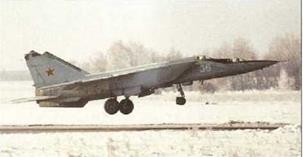
|











